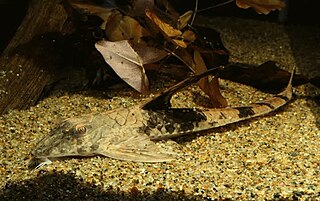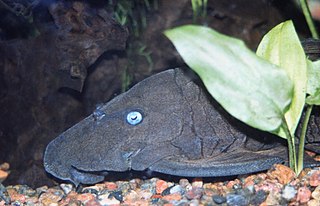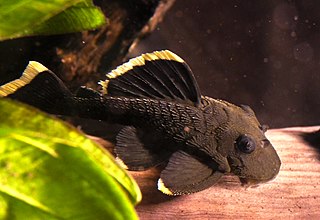
Loricariidae is the largest family of catfish, with 92 genera and just over 680 species. Loricariids originate from freshwater habitats of Costa Rica, Panama, and tropical and subtropical South America. These fish are noted for the bony plates covering their bodies and their suckermouths. Several genera are sold as "plecos", notably the suckermouth catfish, Hypostomus plecostomus, and are popular as aquarium fish.

The genus Panaque contains a small number of small to medium-sized South American suckermouth armoured catfishes that are notable for being among the very few vertebrates that feed extensively on wood. In addition, algae and aufwuchs are an important part of the diet, and they use their rasping teeth to scrape this from rocks. These fish are also popular aquarium fish, where the sound of scraping as these fish forage for food is easily audible.

The blue-eyed plec is a herbivorous freshwater armored catfish endemic to Colombia where it occurs in the Cauca and Magdalena River basins. It is distinguished from many loricariids by being dark grey to black and having bright, turquoise-coloured eyes. Like other species of the genus Panaque, P. cochliodon feeds primarily on submerged wood. Blue-eyed plecs grow to about 30 cm in length and, like other Panaque species, they are clumsy swimmers adapted to staying close the substrate, using their sucker-like mouths to hold on to submerged rocks and wood.

Latimeriidae is the only extant family of coelacanths, an ancient lineage of lobe-finned fish. It contains two extant species in the genus Latimeria, found in deep waters off the coasts of southern Africa and east-central Indonesia. In addition, several fossil genera are known from the Mesozoic of Europe, the Middle East, and the southeastern United States, dating back to the Triassic.

Baryancistrus is a genus of freshwater Loricariid catfish. They inhabit flowing sections of rivers, especially clearwater, in the basins of the Amazon and Orinoco in Brazil and Venezuela. The largest species reach up to 34 cm (13 in) in total length.

Hemiancistrus is a genus of suckermouth armored catfishes. These species are native to South America. The taxonomy of this genus is complex and unclear, and major work has to be done. Many of these fish are popular aquarium fish.

The Hypostominae are a subfamily of catfishes of the family Loricariidae. Most members are restricted to tropical and subtropical South America, but there are also several species in southern Central America. Hypostomus plecostomus, which is popular in the aquarium trade, has been introduced to several regions far from its native range.

Baryancistrus xanthellus is a species of armored catfish endemic to Brazil. It is a benthic fresh water fish that lives in the Volta Grande and Xingu River, as well as the area immediately above Belo Monte falls and the Iriri River. It reaches a length of 22.4 centimetres (8.8 in) SL. It appears in the aquarium trade, where it is typically referred to either by its associated L-numbers, which are L018, L081, L085, L177, LDA60, LDA116 or LDA117; or as the gold nugget pleco.

Panaque armbrusteri is a species of fish in the South American armoured catfish family Loricariidae. This species is distributed throughout the Tapajós river, a large tributary of the Amazon River, with similar populations found in the Xingu, Araguaia, Tocantins and Aripuanã rivers, although it is uncertain whether these populations comprise the same or different species. P. armbrusteri is a large loricariid, reaching 43 cm in total length and reportedly weighing up to 1.3 kg.
Panaque schaeferi is a freshwater species of fish from the South American armoured catfish family Loricariidae. Panaque schaeferi is widely distributed throughout the upper Amazon in Peruvian and Ecuadorian rivers, and it has been observed as far down as Santarém, Brazil. Growing to at least 60 cm SL, it is one of the largest, and likely one of the heaviest species of Loricariid. It has been known in the aquarium trade since at least 1996 under various names such as 'Titanic pleco' and 'Volkswagen pleco', in addition to L203 and LDA065 under the L-number code. Juveniles are often confused with Panaque bathyphilus and erroneously called L090c.

Panaque titan is a species of freshwater fish from the South American armoured catfish family Loricariidae. It is known from several rivers in the Napo River basin in Ecuador, where it was perhaps first encountered in 1975, although it was not scientifically described until 2010. The species reaches at least 39.4 cm SL.

Panaque suttonorum, commonly known as the blue-eye panaque, is a species of freshwater fish from the South American catfish family Loricariidae. It is known from the Maracaibo Basin in Venezuela. In the wild, the species feeds on algae and reaches 28 cm SL, although it may grow larger in captivity.

Galeocerdo alabamensis is an extinct relative of the modern tiger shark. Nomenclature of this shark has been debated, and recent literature identified it more closely with the Physogaleus genus of prehistoric shark, rather than Galeocerdo. The classification of Physogaleus is known as tiger-like sharks while Galeocerdo refers to tiger sharks. In 2003, P. alabamensis was classified as Galeocerdo. However, in 2019 they were proclaimed to be more morphologically similar to the genus Physogaleus. This definition was based primarily on tooth shape, as the majority of information on P. alabamensis is a result of studying tooth fossils. Distinctions between Physogaleus and Galeocerdo are difficult with extinct sharks from the Oilgocene/Miocene as there is little paleobiological information allowing for hard conclusions.

Baryancistrus chrysolomus is a species of armored catfish from South America. It is endemic to the Xingu River basin in Brazil. Adults of the species are most frequently found under flat rocks on the river bottom in places with fine sediments, whereas juveniles are found under rocks in marginal areas near river banks. The species reaches 29.6 cm (11.7 in) in total length and feeds on the diatoms and invertebrate larvae associated with fine sediments such as sand. It is present in the aquarium trade, where it is referred to as the mango pleco or by its L-number, L-047.
Baryancistrus longipinnis is a species of catfish in the family Loricariidae. It is native to South America, where it occurs in the Tocantins River basin in Brazil. The species reaches 20 cm in total length.

Baryancistrus niveatus is a species of catfish in the family Loricariidae. It is native to South America, where it occurs in the basins of the Xingu River, the Tapajós, the Trombetas River, and the Tocantins River in Brazil. This species is among the largest members of the genus Baryancistrus, reaching 34 cm in total length. It sometimes appears in the aquarium trade, where it is known by its L-number, L-026.
Baryancistrus micropunctatus is a species of catfish in the family Loricariidae. It is native to South America, where it occurs in the Jari River basin. The species was described in 2019 by Renildo Ribeiro de Oliveira, Lúcia Rapp Py-Daniel, and Osvaldo Takeshi Oyakawa alongside the species Baryancistrus hadrostomus on the basis of coloration and other characteristics. Its color pattern is noted to be similar to that of its congener Baryancistrus longipinnis, which occurs in the Tocantins River basin.
Panaqolus gnomus, sometimes known as the dwarf panaque, is a species of catfish in the family Loricariidae. It is a freshwater fish native to South America, where it occurs in the basins of the Pastaza River and the Marañón River. The species reaches 7.1 cm SL. It is the type species of the genus Panaqolus, which was historically considered to be a clade of small-sized species within the genus Panaque, hence the common name of this species.
Peckoltia capitulata is a species of catfish in the family Loricariidae. It is native to South America, where it occurs in the Approuague River in French Guiana. It was initially collected from an area of the river with a swift, strong current that was noted to be unusually turbid at the time of collection due to illegal gold mining in the area. The species reaches 7.6 cm SL. Its specific epithet, capitulata, is derived from Latin and reportedly refers to the characteristically small head of the species.












